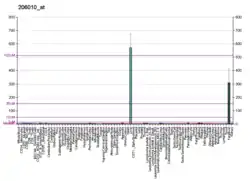HABP2
Hyaluronan-binding protein 2 also known as factor VII activating protease (FSAP) is a protein that in humans is encoded by the HABP2 gene.[5][6][7]
| HABP2 | |||||||||||||||||||||||||
|---|---|---|---|---|---|---|---|---|---|---|---|---|---|---|---|---|---|---|---|---|---|---|---|---|---|
| Identifiers | |||||||||||||||||||||||||
| Aliases | HABP2, FSAP, HABP, HGFAL, PHBP, NMTC5, hyaluronan binding protein 2 | ||||||||||||||||||||||||
| External IDs | OMIM: 603924 MGI: 1196378 HomoloGene: 3050 GeneCards: HABP2 | ||||||||||||||||||||||||
| |||||||||||||||||||||||||
| |||||||||||||||||||||||||
| |||||||||||||||||||||||||
| |||||||||||||||||||||||||
| Orthologs | |||||||||||||||||||||||||
| Species | Human | Mouse | |||||||||||||||||||||||
| Entrez | |||||||||||||||||||||||||
| Ensembl | |||||||||||||||||||||||||
| UniProt | |||||||||||||||||||||||||
| RefSeq (mRNA) | |||||||||||||||||||||||||
| RefSeq (protein) | |||||||||||||||||||||||||
| Location (UCSC) | Chr 10: 113.55 – 113.59 Mb | Chr 19: 56.29 – 56.32 Mb | |||||||||||||||||||||||
| PubMed search | [3] | [4] | |||||||||||||||||||||||
| Wikidata | |||||||||||||||||||||||||
| |||||||||||||||||||||||||
The protein encoded by this gene is an extracellular serine protease which binds hyaluronic acid. It is involved in cell adhesion. The protein is synthesized as a single chain, but then undergoes an autoproteolytic event to form the functional heterodimer. Further autoproteolysis leads to smaller, inactive peptides. Two transcript variants utilizing alternative polyA sites exist for this gene.[7]
References
- GRCh38: Ensembl release 89: ENSG00000148702 - Ensembl, May 2017
- GRCm38: Ensembl release 89: ENSMUSG00000025075 - Ensembl, May 2017
- "Human PubMed Reference:". National Center for Biotechnology Information, U.S. National Library of Medicine.
- "Mouse PubMed Reference:". National Center for Biotechnology Information, U.S. National Library of Medicine.
- Choi-Miura NH, Tobe T, Sumiya J, Nakano Y, Sano Y, Mazda T, Tomita M (Dec 1996). "Purification and characterization of a novel hyaluronan-binding protein (PHBP) from human plasma: it has three EGF, a kringle and a serine protease domain, similar to hepatocyte growth factor activator". J Biochem. 119 (6): 1157–65. doi:10.1093/oxfordjournals.jbchem.a021362. PMID 8827452.
- Romisch J (Nov 2002). "Factor VII activating protease (FSAP): a novel protease in hemostasis". Biol Chem. 383 (7–8): 1119–24. doi:10.1515/BC.2002.121. PMID 12437095. S2CID 37767393.
- "Entrez Gene: HABP2 hyaluronan binding protein 2".
Further reading
- Gupta S, Batchu RB, Datta K (1992). "Purification, partial characterization of rat kidney hyaluronic acid binding protein and its localization on the cell surface". Eur. J. Cell Biol. 56 (1): 58–67. PMID 1724753.
- Sumiya J, Asakawa S, Tobe T, et al. (1998). "Isolation and characterization of the plasma hyaluronan-binding protein (PHBP) gene (HABP2)". J. Biochem. 122 (5): 983–90. doi:10.1093/oxfordjournals.jbchem.a021861. PMID 9443814.
- Choi-Miura NH, Yoda M, Saito K, et al. (2001). "Identification of the substrates for plasma hyaluronan binding protein". Biol. Pharm. Bull. 24 (2): 140–3. doi:10.1248/bpb.24.140. PMID 11217080.
- Choi-Miura NH, Takahashi K, Yoda M, et al. (2001). "Proteolytic activation and inactivation of the serine protease activity of plasma hyaluronan binding protein". Biol. Pharm. Bull. 24 (5): 448–52. doi:10.1248/bpb.24.448. PMID 11379758.
- Roemisch J, Feussner A, Nerlich C, et al. (2003). "The frequent Marburg I polymorphism impairs the pro-urokinase activating potency of the factor VII activating protease (FSAP)". Blood Coagul. Fibrinolysis. 13 (5): 433–41. doi:10.1097/00001721-200207000-00008. PMID 12138371. S2CID 39490260.
- Wang KK, Liu N, Radulovich N, et al. (2002). "Novel candidate tumor marker genes for lung adenocarcinoma". Oncogene. 21 (49): 7598–604. doi:10.1038/sj.onc.1205953. PMID 12386823.
- Etscheid M, Beer N, Fink E, et al. (2003). "The hyaluronan-binding serine protease from human plasma cleaves HMW and LMW kininogen and releases bradykinin" (PDF). Biol. Chem. 383 (10): 1633–43. doi:10.1515/BC.2002.184. PMID 12452440. S2CID 18939354.
- Strausberg RL, Feingold EA, Grouse LH, et al. (2003). "Generation and initial analysis of more than 15,000 full-length human and mouse cDNA sequences". Proc. Natl. Acad. Sci. U.S.A. 99 (26): 16899–903. doi:10.1073/pnas.242603899. PMC 139241. PMID 12477932.
- Willeit J, Kiechl S, Weimer T, et al. (2003). "Marburg I polymorphism of factor VII--activating protease: a prominent risk predictor of carotid stenosis". Circulation. 107 (5): 667–70. doi:10.1161/01.CIR.0000055189.18831.B1. PMID 12578864.
- Anderson NL, Polanski M, Pieper R, et al. (2004). "The human plasma proteome: a nonredundant list developed by combination of four separate sources". Mol. Cell. Proteomics. 3 (4): 311–26. doi:10.1074/mcp.M300127-MCP200. PMID 14718574.
- Deloukas P, Earthrowl ME, Grafham DV, et al. (2004). "The DNA sequence and comparative analysis of human chromosome 10". Nature. 429 (6990): 375–81. doi:10.1038/nature02462. PMID 15164054.
- Hoppe B, Tolou F, Radtke H, et al. (2005). "Marburg I polymorphism of factor VII-activating protease is associated with idiopathic venous thromboembolism". Blood. 105 (4): 1549–51. doi:10.1182/blood-2004-08-3328. PMID 15486068.
- Gerhard DS, Wagner L, Feingold EA, et al. (2004). "The Status, Quality, and Expansion of the NIH Full-Length cDNA Project: The Mammalian Gene Collection (MGC)". Genome Res. 14 (10B): 2121–7. doi:10.1101/gr.2596504. PMC 528928. PMID 15489334.
- Ireland H, Miller GJ, Webb KE, et al. (2005). "The factor VII activating protease G511E (Marburg) variant and cardiovascular risk" (PDF). Thromb. Haemost. 92 (5): 986–92. doi:10.1160/TH04-05-0275. PMID 15543324.
- Nakazawa F, Kannemeier C, Shibamiya A, et al. (2005). "Extracellular RNA is a natural cofactor for the (auto-)activation of Factor VII-activating protease (FSAP)". Biochem. J. 385 (Pt 3): 831–8. doi:10.1042/BJ20041021. PMC 1134760. PMID 15654766.
- van Minkelen R, de Visser MC, Vos HL, et al. (2005). "The Marburg I polymorphism of factor VII-activating protease is not associated with venous thrombosis". Blood. 105 (12): 4898, author reply 4899. doi:10.1182/blood-2005-02-0576. PMID 15933067.
- Etscheid M, Beer N, Dodt J (2006). "The hyaluronan-binding protease upregulates ERK1/2 and PI3K/Akt signalling pathways in fibroblasts and stimulates cell proliferation and migration". Cell. Signal. 17 (12): 1486–94. doi:10.1016/j.cellsig.2005.03.007. PMID 16153533.
This article is issued from Wikipedia. The text is licensed under Creative Commons - Attribution - Sharealike. Additional terms may apply for the media files.




